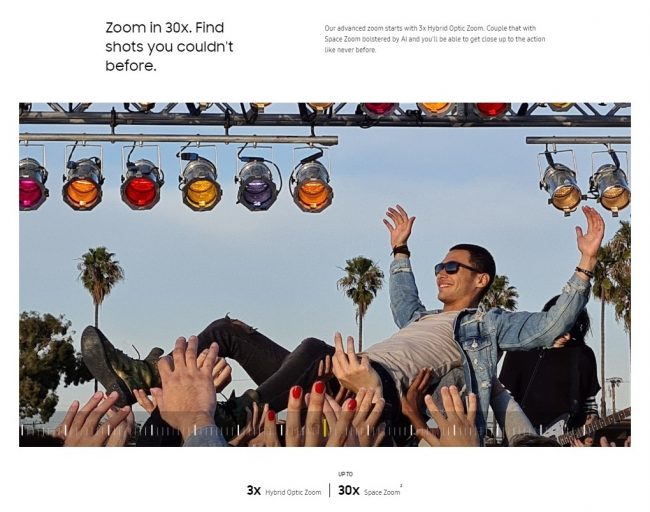Table of Contents
Zoom on a phone is often not what it claims to be.

The cameras of most phones are already very good quality and even in the lower classes, you will not usually encounter absolutely terrible results. Manufacturers have to invent new features and abilities, which at least try to triumph the competition.
Zoom on a phone: forget for ads
Recently, we have noticed a trend where information about the zoom capabilities of a given model comes to the fore. The manufacturer typically publishes a staggering zoom figure that the phone is capable of. However, it does not always clearly state whether it is true optical zoom or just digital zoom. In addition, concepts such as hybrid zoom appear, but they can easily confuse the ignorant customer.
Introducing #OPPOReno2 #Quadcam with #20xZoom. Coming first to India on 28.08.2019 pic.twitter.com/ySwRdeoXLa
— OPPO India (@oppomobileindia) August 16, 2019
In this article, therefore, we look at the differences between technologies and tell us a bit about how manufacturers often obscure the facts somewhat.
Optical zoom
Optical zoom is a fixed zoom lens in the context of phones. The magnification may be different, for example two or five times. Unlike conventional cameras, however, the need to fit lenses in a small space is not variable. Any intermediate steps between standard shot and optical magnification are solved digitally, which will be discussed later.
Telephoto lenses are not long for nothing. The lenses simply take up some space, which is a problem on smartphones. Manufacturers must therefore come up with creative solutions.
Importantly, optical zoom is the only way to really zoom in and capture data that you can’t take with a standard camera. As such, it has the greatest ‘marketing value’, and therefore this label is sometimes misused for solutions that do not.
Digital zoom
Digital zoom is a “technology” that allows phones to achieve easy a hundredfold “zoom”. Manufacturers like to use this in their promotional materials, but somehow do not explain what it is. Most of our readers probably understand the pitfalls of this solution, but not every customer is oriented in this issue.
Digital zoom is simply nothing but trimming. If you take a classic, close-up photo and then cut it out to enlarge it to its original resolution, you have a digital zoom. The camera application does exactly the same, only in real time.
However, because upscaling (enlargement to the original resolution) almost always occurs, not everyone has to realize that in reality this way no other image data can be obtained. For example, if you digitally zoom in on a 8Mpx sensor to capture a 1Mpx image of the sensor, you can capture exactly as many pixels. Although the camera application immediately enlarges this 1Mpx photo to its original resolution, the points thus obtained are purely digitally calculated and the result will therefore appear pixelized and contain no more details than you would get without zooming in.
Hybrid zoom
In recent years it has also been known as hybrid zoom, super-res zoom and so on. This is again more or less digital zoom, but somewhat more sophisticated. Instead of simply recalculating the viewport to its original resolution, other technologies are also emerging. In addition, digital zoom is usually applied to an image taken with an optical zoom, hence the hybrid. The first phone on which this technology worked really well was the Huawei P30 Pro.
In practice, for example, various AI technologies are used, which can detect the scene and better “guess” the pixels needed to get a higher resolution. For example, Google or Huawei also use solutions that take multiple shots when shooting a close-up scene. These are then compared with each other, and due to the slight differences between them, the phone software can better calculate the missing data and achieve a truly more detailed picture than it would be possible to get from a single photograph.
Hybrid zoom technology provides better results than ordinary digital zoom. The quality of the resulting photos depends a lot on the implementation of a particular manufacturer, but can be quite decent even at multiple zooms. Similarly, astronomers use similar technology to improve images from various telescopes, which in turn need to remove “noise” and other negative effects.
But even the best hybrid zoom by definition cannot capture as much detail as true optical zoom.
When the optical zoom is not completely optical
Even with large brands, it is not entirely possible to rely on the fact that the designation of their zoom type corresponds to reality. For example, the Xiaomi Mi Note 10 boasts a 5x optical zoom, which is even written next to the camera lens on the back cover of the phone.

But the reality is different. The optical zoom is only 3.7x and applied to an 8Mpx sensor. However, the resulting photographs are 5 × zoomed in 5Mpx resolution. Xiaomi simply solves the difference between optical and indicated zoom digitally. But because Xiaomi directly indicates the camera’s zoom resolution lower than the hardware resolution of the sensor, company representatives seem to feel that it is a hardware and therefore optical zoom.
Similarly, the OnePlus model of the OnePlus 7 Pro, which was designed to offer triple optical zoom, has been preserved. In reality, however, the zoom is only 2.2x and captured on a 13Mpx sensor. The resulting photo is then cropped to an 8Mpx image at 3x magnification.
Magics with numbers in Samsung
Samsung could not resist similar loops on its latest Galaxy S20 series. With the top-of-the-range Galaxy S20 Ultra Samsung, it features a 10x hybrid-optic zoom. From the name it is obvious that it will not be quite optical zoom. Indeed, the company admitted, on direct question, that the phone optically offers only four times the magnification and the rest is resolved digitally.

Even worse, according to NotebookCheck, are S20 and S20 Plus models. They reportedly offer only a very weak 1.06x optical zoom. The three-fold magnification is therefore almost exclusively digital.
In the case of the “100 × Space Zoom” technology, which proudly boasts the Galaxy S20 Ultra, it is also predominantly digital zoom, but Samsung admits it. In the specifications, this magnification is referred to as “artificial intelligence-driven digital zoom”. To achieve better results, a number of interesting software tricks are used, which are based mainly on taking multiple shots at the same time, which we described above.
A little sincerity wouldn’t hurt
In a relatively short period of time, manufacturers have been able to bring the photographic capabilities of phones to a very decent level, including zoom. From primitive digital magnification, within a few years we have come to a multiple optical zoom and often a surprisingly decent hybrid zoom that can produce crisp, detailed images using AI.
It is a pity, however, that marketing departments often juggle terms as they fit.While in “no name” manufacturers we could understand this, but brands like Xiaomi, OnePlus or Samsung might leave it . It has to be said that these companies specified their operation sooner or later. Only this was not always apparent in the performance and marketing materials.
Summary
If zoom on a phone is important for you, forget to choose your model based on ads and try to learn more about the model.
- Dogecoin Price Analysis – January 14, 2025 - January 14, 2025
- Bitcoin (BTC) Price Analysis – January 13, 2025 - January 13, 2025
- Baby Doge Coin (BABYDOGE) Price Analysis – January 13, 2025 - January 13, 2025
























